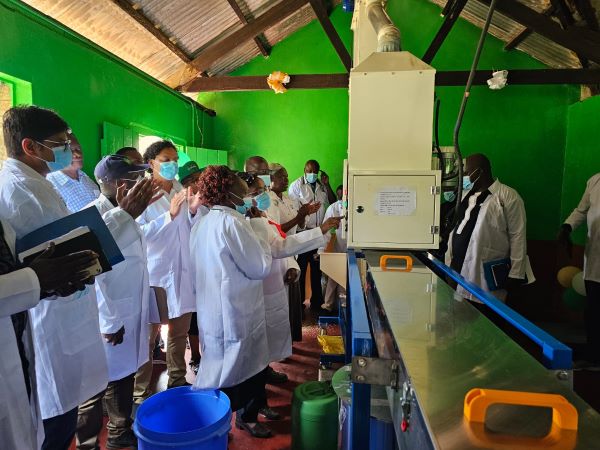
The rice sector in Kenya is set for a major boost after the International Rice Research Institute (IRRI) donated a seed dresser to the Kenya Agricultural and Livestock Research Organization (KALRO).
This has been considered as a game-changing initiative that has the potential not only to boost quality seed supply but also trigger the overall growth of the rice value chain in western Kenya.
According to Dr. Sankalp Bhosale, IRRI scientists and Deputy Head of Rice Breeding Innovations who attended the turnover event, capacity building on quality seed production and establishment of Private-Public-Partnerships (PPPs) to enhance the scale of quality seed is among the crucial elements of the model which IRRI has provided immense support.
The seed dresser is expected to increase the capacity of KALRO, the custodian of breeder seed of the rice varieties jointly released with IRRI and hence a key party in recent PPPs, to produce both early generation (breeder and foundation) seed and certified seed to be distributed to farmers by seed companies, farmers’ cooperatives, and women groups.
Speaking during the event, Dr. Ajay Panchbhai, the Regional Breeding and Seed Systems Lead for Africa, mentioned “The huge import of rice to Africa is a challenge to all stakeholders to work together to increase production and that robust technologies would play a crucial role to achieve rice self-sufficiency. This can be possible through adoption of high-yielding improved rice varieties coupled with the use of quality seed”.
New frontier for rice production
The Kenyan government highly considers the western region as the new frontier for rice production owing to the availability of vast land suitable for rice production and the abundance of water resources for irrigation.
Despite the region being home to more than ten irrigation schemes such as Ahero, Westkano, Southwest Kano, Aluch Kimira, Bunyala, Lower Kuja, and Gem Rae) with an estimated area of over 20,000 hectares under rice cultivation, its contribution to the national rice grid is only about 20%.
According to the statistics from Kenya’s Ministry of Agriculture and Livestock Development for the year 2022, paddy rice production stood at 125,000 tons, with western Kenya contributing only 20,000 tons of the total production.
Absence of market-preferred rice varieties
Lack of varieties carrying market-preferred traits has been the leading cause for the low demand and competitiveness of locally-produced rice leading to the bulk of it being sold to neighboring countries at low prices to the detriment of local farmers.
The net effect has been weak linkages in the rice value chain and a weak seed system that could not respond to and meet farmers’ demands. New and high-yielding varieties jointly released by KALRO and IRRI such as IR 05N221 that have consumer-preferred traits offer an opportunity to reverse this trend.
Dr. Mary Mutembei, Head of the Rice Promotion Program in Kenya, highlighted that the government is committed to the rice agenda through the revised National Rice Development Strategy II (2019-2030) of the country towards attaining self-sufficiency which aims at increasing production to meet 80% of the local consumption by the year 2027 (brought forward from 2030).
She encouraged farmers to use certified seeds, especially now that the seed shortage will be resolved, thanks to the training and infrastructure support, like the seed dresser, provided by IRRI.
Bottlenecks to quality seeds
The donation of a seed dresser comes after several IRRI-facilitated workshops that brought together stakeholders in the rice value chain to identify bottlenecks hindering the availability and scale of quality seeds of improved rice varieties in the region.
Between 2021 and 2022, three workshops were held with participation from the Ministry of Agriculture from both national and regional governments, millers, seed companies, and farmer organizations that led to the conceptualization of the seed system model for the region.
Dr. Caroline Kundu, Center Director of KALRO-Kibos, concluded the event with assurance to put the seed dresser to its best use ensuring the quality seed supply of the improved rice varieties for the smallholder farmers in western Kenya, thus contributing to rice self-sufficiency in the country.
Local partners’ benefit
The donation is intended for local partners in the region, including NARES, non-government organizations, farmers’ cooperatives, and women groups to ensure them access to quality seeds of new varieties as part of an ongoing Accelerated Genetic Gain in Rice (AGGRi) Alliance initiative funded by the Bill and Melinda Gates Foundation (BMGF).
Commenced in 2019, AGGRi Alliance has made significant contributions to unifying and modernizing rice breeding and seed systems efforts in South Asia and Sub-Saharan Africa. The efforts of strengthening rice seed systems in East and Southern Africa are also aptly complimented through the OneCGIAR Seed Equal initiative.








